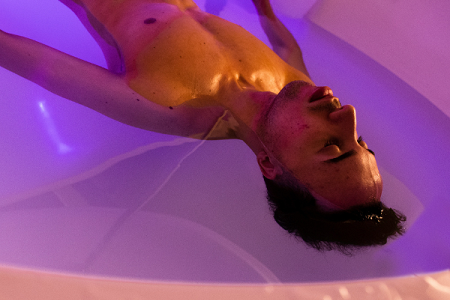Can’t stand being alone with your thoughts? Here’s how floating can help…
Floating is the perfect environment to develop and mediation and mindfulness practice

What are you thinking about right now?
It’s a difficult question to answer, isn’t it? To do so, you have to draw your attention directly to what’s going through your mind at this very moment – which, while you’re reading this, perhaps listening to music or with the TV playing quietly in the background, is hard to do.
Maybe you’ve got some incense burning, or just caught a whiff of yesterday’s gym kit that’s stagnating over in your washing basket.
Maybe you’re anxious thinking about tomorrow, or something stupid you said yesterday that you’re now regretting.
At any one time, all these sensory and internal stimuli could be developing thoughts in your mind, making it difficult to bring your attention to any one thing. And we all know that when we let our brains run amok on one particular subject, what often happens is we jump to the wildest of conclusions.
But that’s not to say this process can’t be controlled. Meditation, yoga, breathwork and mindfulness are all commonly-used tools to clear our heads of thoughts.
Indeed, the ultimate goal of those who consider themselves on the path of enlightenment – the yogis, the Buddhists, the meditators and more – is to reach a point where you are completely devoid of thought; a point where your own ego disappears and you just are. It’s a process some dedicate their entire lifetimes to perfecting. But we know a cheeky hack to get there. Have you guessed it yet?
Yep, floating is often referred to as the shortcut to the meditative state. The very aim of the float tank is to remove all sensory input so that you can relax your mind to the point of clarity. And yes, that does mean being left alone with your thoughts – but eventually, you can reach a point where you’re observing your thoughts from the outside, not letting them dictate your own emotional state.
Joe Rogan described this process in an episode of his podcast The Joe Rogan Experience: “It’s like layers of an onion; when you first start doing the isolation tank, you only get a couple of layers in – a couple of skins loose. You can’t really go to the core, it’s too hard to completely let go of who you are. But as you get better at it, you get better at actually letting go; letting go from letting go; letting go from the feeling of letting go; letting go from that point. ‘Okay I’ve let go’ – no you haven’t – let go more. And then you become… gone. You disappear. And while you’re disappearing, you think ‘I can’t believe this is happening, I’m disappearing’, then you go back again, you’ve got to start from square one. You’ve got to get to the point where you literally completely relax.”
In a later episode he sums up the process of repeatedly letting go ever so succinctly: “Every time you do that is like a bicep curl for your mind.”
And he’s right! After training your brain in this way enough times, you’ll get to a point where you can observe your thoughts in the same fashion outside of the tank, too.
When a negative thought pops into your head while you’re walking down the street – “Hey! Nobody loves you! You look terrible today! Etc.” – you will be able to observe it, process it and let it go, almost as if you’re watching a movie of the constant chattering in your head on TV, relating to the thoughts or characters you so wish.
If you find that concept a tough one to wrap your head around, consider it this way: you are not your thoughts. Understand that, and the battle is already half won.
Your mind is one of the most powerful facets of nature that we are still a long way from fully understanding, but being left alone with it isn’t something to fear. That fear is a thought in itself – one you are totally capable of observing, processing, and letting go.
You. Are. Not. Your. Thoughts.
If the idea of being left alone with your thoughts is putting you off your first float, pop in to see us in Vauxhall so we can further put your mind at ease!










